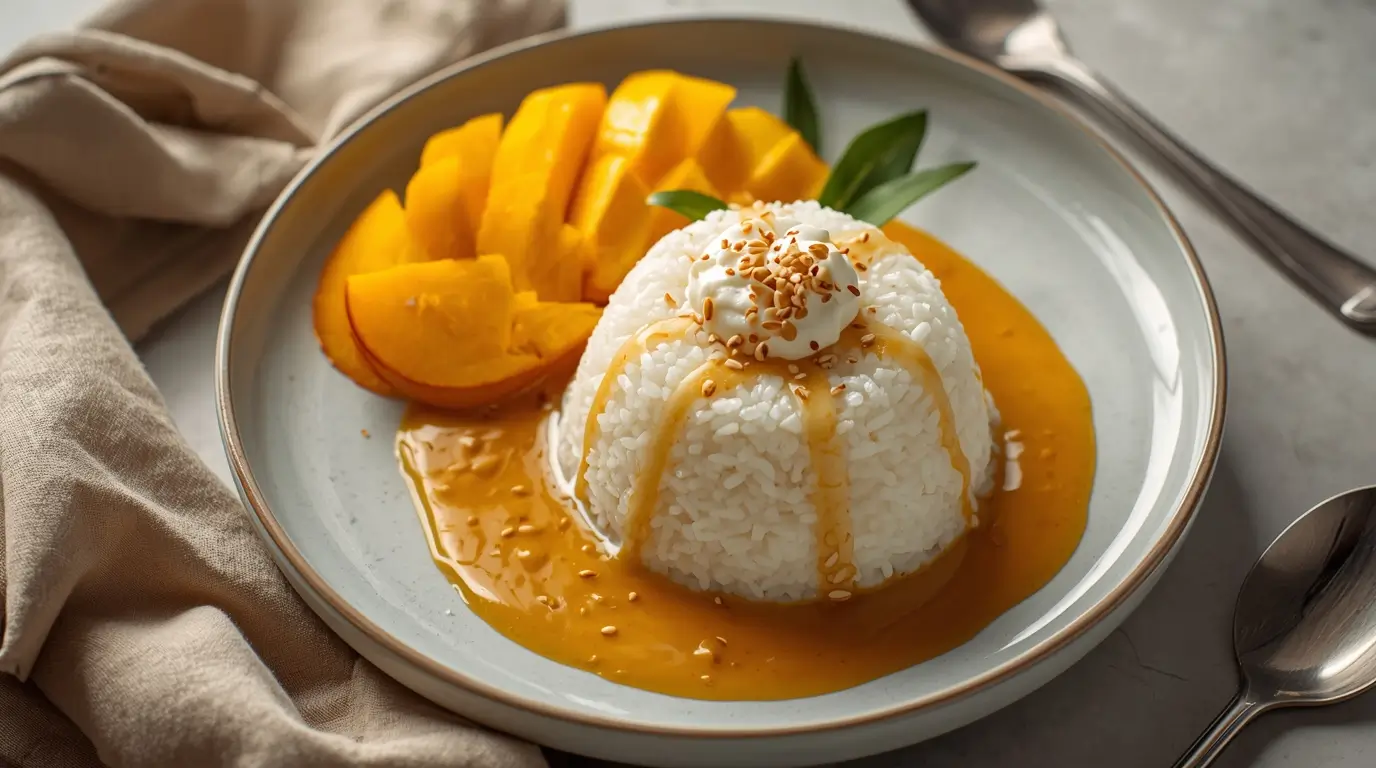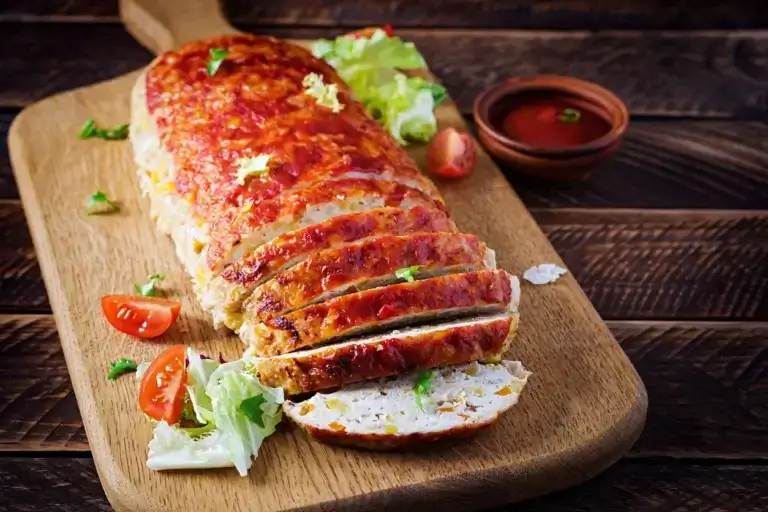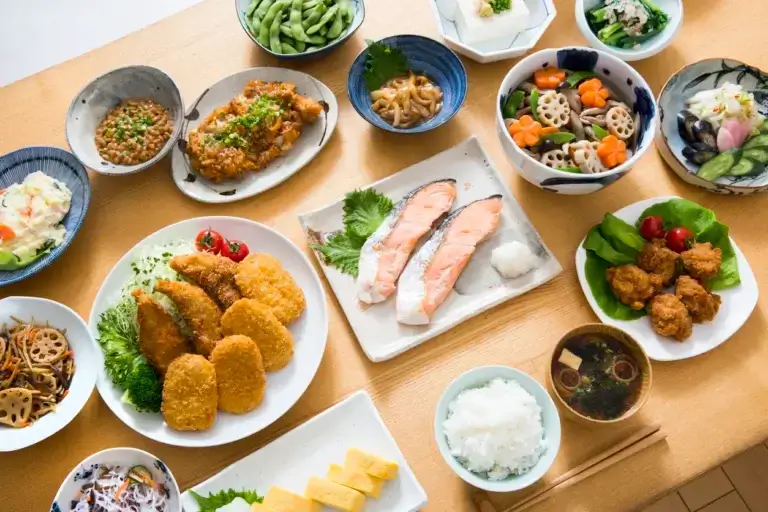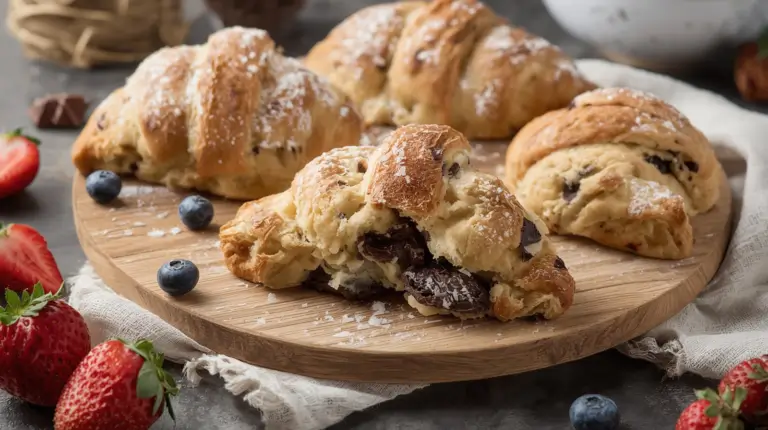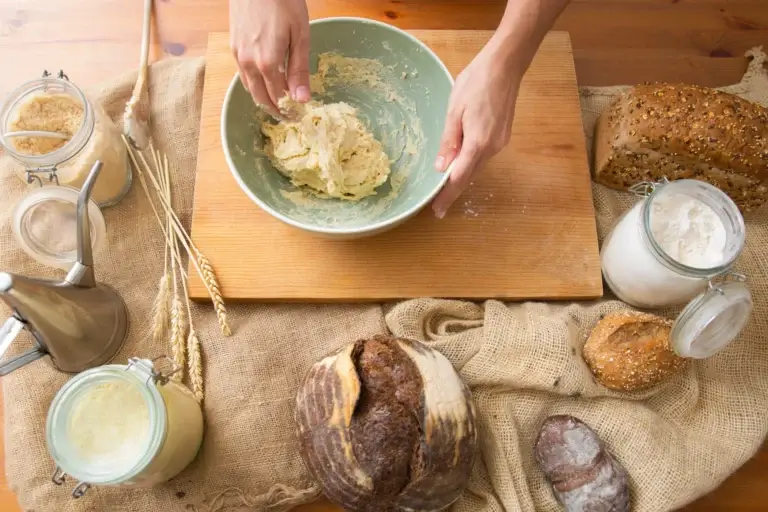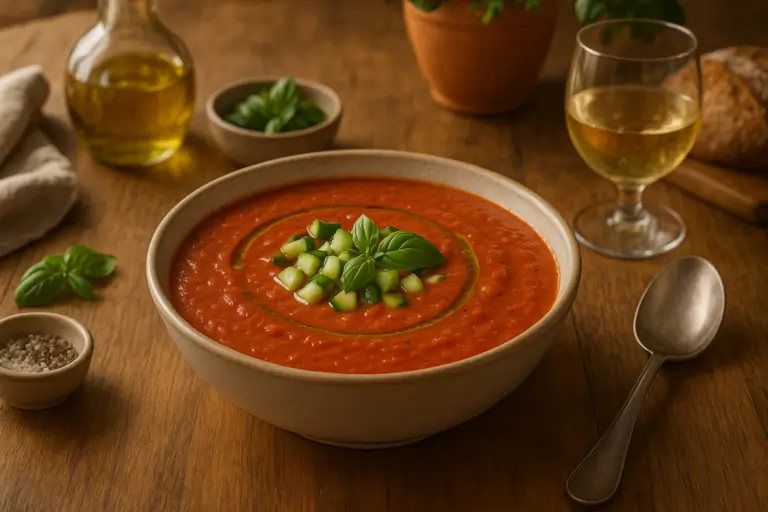How to Make Mango Sticky Rice – A Perfect Asian Dessert
When you’re craving something that hits differently than your usual chocolate cake or ice cream, this authentic mango sticky rice recipe delivers a perfect balance of creamy coconut, tender glutinous rice, and sweet tropical fruit that feels like a warm hug from Southeast Asia. This comprehensive guide will walk you through creating this beloved asian dessert that has captivated food lovers across the globe. Among all asian desserts, this one stands out for its simplicity and authentic flavors.
Learning to master this easy asian dessert transforms your kitchen into a Thai street food paradise. The simple ingredients, gentle cooking method, and stunning presentation make this one of the most rewarding asian desserts to prepare at home, whether you’re planning chinese new year dessert ideas or just treating yourself on a Tuesday night. This classic asian dessert recipe has become a staple in homes worldwide.
Table of Contents
After the step-by-step recipe, explore enriched content packed with Asian Desserts secrets, ingredient swaps, and pro tips that’ll elevate your cooking game.
Recipe Overview
| Prep Time | Cook Time | Total Time | Servings |
|---|---|---|---|
| 15 mins (plus 4 hours soaking) | 30 mins | 4 hours 45 mins | 4-6 |
Ingredients
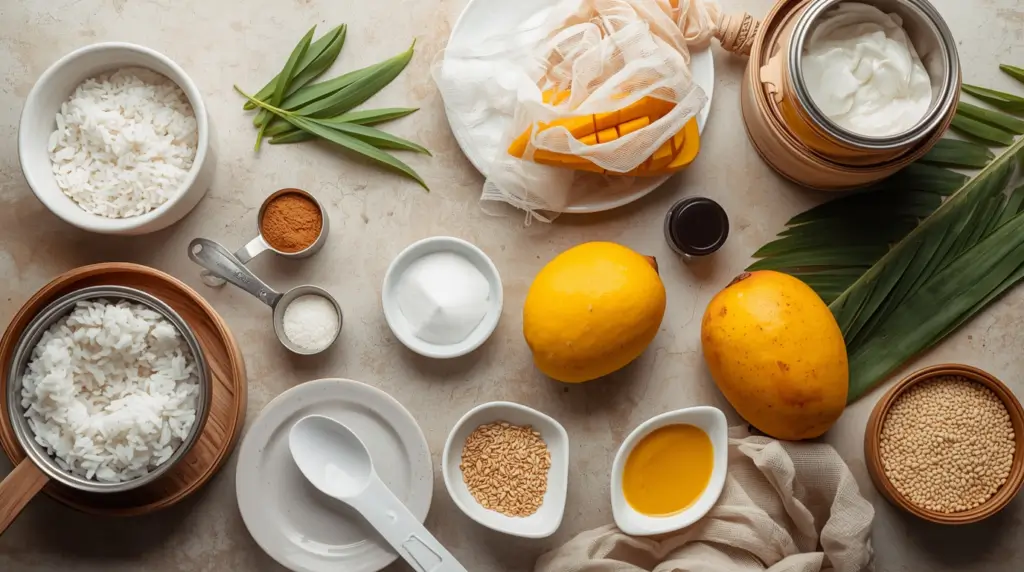
For the Sweet Sticky Rice:
- 2 cups glutinous rice (also called sweet rice or sticky rice)
- 2 1/2 cups water (for soaking)
- Banana leaf or cheesecloth (for steaming)
For the Coconut Sauce:
- 1 can (14 oz/400ml) full-fat coconut milk
- 1/2 cup palm sugar (or light brown sugar)
- 1/2 teaspoon salt
- 2 pandan leaves (or 1 teaspoon vanilla extract)
For Assembly:
- 3-4 ripe mangoes (Ataulfo or Manila varieties work best)
- 3 tablespoons coconut cream (the thick part from the top of the can)
- 2 tablespoons toasted sesame seeds (white or black)
- 2 tablespoons mung beans, cooked (optional, traditional garnish)
Recipe Variations & Adaptations
- Vegan-Friendly: This recipe is naturally vegan and dairy-free, perfect for plant-based diets.
- Sugar Alternatives: Use coconut sugar for deeper caramel notes, or reduce sugar by 1/4 cup for less sweetness.
- Fruit Swaps: Try with ripe durian, fresh jackfruit, or sliced strawberries when mangoes aren’t in season.
- Color Variations: Add butterfly pea flower tea to coconut milk for stunning blue rice, or use pandan juice for natural green color.
- Quick Method: Use a rice cooker with sticky rice setting to cut cooking time in half.
- Make-Ahead Version: Prepare rice up to 2 days ahead; warm gently with a splash of coconut milk before serving.
Step-by-Step Instructions
Preparing the Glutinous Rice
Initial Preparation:
- Measure 2 cups of glutinous rice into a large bowl
- Rinse rice under cold running water, swishing with your hands
- Drain and repeat rinsing 4-5 times until water runs almost clear
- Cover rice with cold water (about 2 1/2 cups)
- Let soak minimum 4 hours (overnight in refrigerator for best results)
Setting Up Your Steamer:
- Fill the bottom pot of your steamer with water
- Bring water to a rolling boil
- Line your steamer basket with banana leaf or several layers of cheesecloth
- Make sure cheesecloth edges hang over the sides for easy removal
Steaming the Rice:
- Drain soaked rice thoroughly in a fine-mesh strainer
- Spread drained rice evenly in the lined steamer basket
- Keep rice layer no more than 1 1/2 inches thick for even cooking
- Cover steamer with tight-fitting lid
- Steam over high heat for 25-30 minutes without lifting the lid
- Rice is done when grains are translucent, tender, and slightly glossy
Creating the Perfect Coconut Sauce
Sauce Preparation:
- Shake coconut milk can well before opening
- Reserve 3 tablespoons of the thickest coconut cream for topping
- Pour remaining coconut milk into a medium saucepan
- Add palm sugar and salt to the pan
- If using pandan leaves, bruise them by twisting to release oils, then add to pan
Cooking the Sauce:
- Heat coconut mixture over low-medium heat, stirring frequently
- Never let the mixture come to a full boil (gentle heat prevents separation)
- Stir until sugar completely dissolves, about 5-6 minutes
- The sauce should be warm, smooth, and slightly thickened
- Remove from heat and discard pandan leaves if used
Combining Rice and Sauce:
- Transfer hot steamed rice to a large mixing bowl
- Measure out 1 1/4 cups of the warm coconut sauce
- Pour sauce over rice gradually while folding gently with a spatula
- Use a folding motion to avoid crushing grains (don’t stir vigorously)
- Cover bowl with a clean kitchen towel
- Let rice absorb the sauce for 15-20 minutes at room temperature
Preparing the Mangoes
- Choose mangoes that yield slightly to gentle pressure and smell sweet at the stem
- Wash mangoes under cool water and pat dry
- Stand mango on its narrow end on cutting board
- Slice down each side of the flat pit to create two “cheeks”
- Score the flesh in a crosshatch pattern without cutting through the skin
- Or cut into thin lengthwise slices for elegant presentation
Final Assembly & Plating
Traditional Presentation:
- Use a small bowl or cup to shape sticky rice into neat mounds
- Place rice mound on one side of the plate
- Arrange mango slices in a fan pattern beside the rice
- Drizzle the thickened coconut topping over the rice
- Sprinkle with toasted sesame seeds
- Add cooked mung beans if using for authentic touch
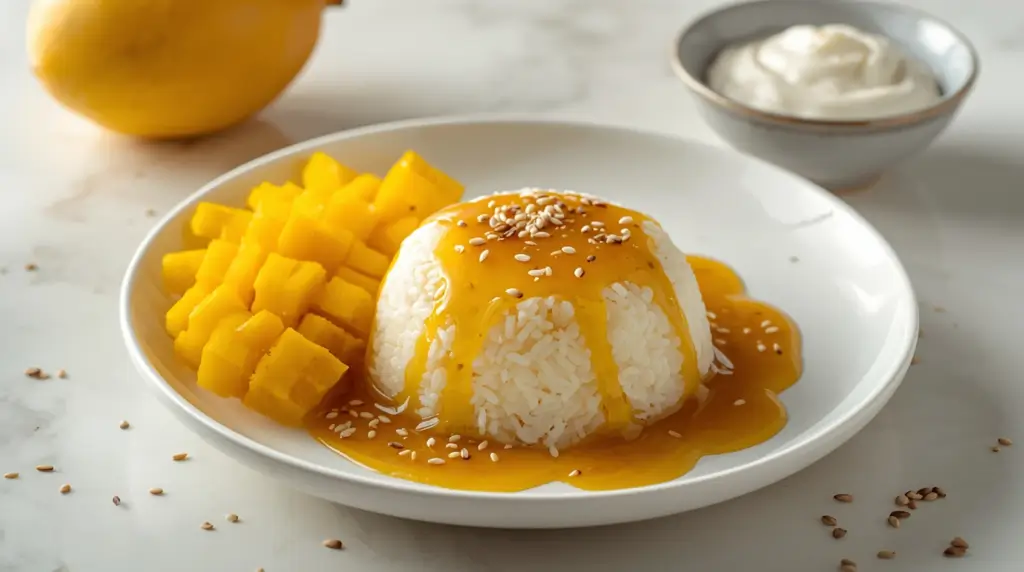
Nutritional Benefits of This Asian Dessert
This beloved asian dessert offers more than just incredible flavor. Mangoes deliver vitamins A and C along with dietary fiber, while coconut milk provides beneficial MCTs for sustained energy. Glutinous rice is naturally gluten-free and offers complex carbohydrates without the excessive sugar found in many Western desserts. Compared to other asian desserts, this one provides a balanced nutritional profile.
| Nutrient | Amount per Serving |
|---|---|
| Calories | 380 |
| Total Fat | 14g |
| Saturated Fat | 11g |
| Cholesterol | 0mg |
| Sodium | 240mg |
| Total Carbohydrates | 62g |
| Dietary Fiber | 4g |
| Sugars | 28g |
| Protein | 5g |
| Vitamin A | 35% DV |
| Vitamin C | 45% DV |
Discover expert tips and creative twists to master authentic mango sticky rice at home!
Why This Recipe Will Become Your Favorite
Restaurant-quality results that rival the best Thai restaurants can be achieved in your home kitchen. This simple technique looks impressive but requires no special culinary skills or equipment. It’s naturally gluten-free and vegan, accommodating various dietary preferences without modifications. The make-ahead friendly components allow stress-free entertaining, and the universally loved flavor profile appeals to adults and children alike. Budget-friendly ingredients deliver gourmet results while connecting you to centuries of Southeast Asian culinary tradition, making this asian dessert a crowd-pleaser at any gathering.
From Street Food Treasure to Global Phenomenon
Walk through Bangkok’s bustling streets at dusk, and you’ll find vendors preparing hundreds of portions of mango sticky rice in massive steamer baskets. This simple yet sublime asian desert didn’t start in fancy restaurants; it emerged from Thailand’s agricultural heartland where rice paddies and mango orchards grew side by side. Today, this asian dessert has become a global favorite.
Farmers discovered that when monsoon season ended and mangoes ripened, they could transform their staple sticky rice into something celebratory. The addition of coconut milk, extracted fresh from local coconuts, created the perfect bridge between the rice’s subtle flavor and the mango’s intense sweetness.
The Science Behind Perfect Texture
The magic of mango sticky rice lies in understanding the unique properties of glutinous rice. Unlike regular rice with its mix of amylose and amylopectin starches, glutinous rice contains almost pure amylopectin. This creates that distinctive sticky, slightly chewy texture that holds together beautifully while remaining tender.
When warm coconut milk meets hot rice, the fat molecules coat each grain while the rice absorbs the sweetened liquid. This dual action creates incredible richness without making the rice soggy or greasy. The 15-minute rest period allows this integration to reach perfection.
Selecting Quality Ingredients for Authentic Flavor
Creating exceptional mango sticky rice starts with understanding each ingredient’s role and choosing the best available options. Quality ingredients make the difference between a good asian dessert and a transcendent one.
- Glutinous Rice Selection: Look for “Three Ladies” brand from Thailand for consistent quality and proper stickiness. The grains should be pure white without any yellowing or off odors. This is the foundation of any great asian dessert.
- Coconut Milk Quality: Thai brands like Chaokoh or Aroy-D deliver authentic richness and proper fat content. Avoid “lite” coconut milk, which separates during heating and lacks the necessary creaminess.
- Mango Varieties: Ataulfo (champagne) mangoes offer the perfect sweetness and fiber-free texture for this asian dessert. Manila mangoes work beautifully too. Ripe mangoes should smell sweet and yield gently to pressure near the stem.
- Palm Sugar vs Substitutes: Traditional palm sugar adds subtle caramel notes that brown sugar can approximate. If unavailable, use light brown sugar mixed with a teaspoon of molasses for closer flavor.
Professional Techniques for Perfect Results
Common Mistakes That Ruin the Dish
Skipping the Soak: This is the number one error that guarantees failure. Unsoaked glutinous rice never achieves proper texture. The grains remain hard in spots, and no amount of steaming fixes this. Always plan ahead for the 4-hour minimum soak.
Using Regular Rice: Even if you soak regular jasmine or long-grain rice, it will never become sticky. The starch structure is fundamentally different. Glutinous rice is essential and non-negotiable for authentic results.
Boiling the Coconut Milk: High heat causes coconut milk to separate into oil and grainy solids, completely ruining the sauce texture. Keep temperatures gentle and patient.
Adding Sauce to Cold Rice: The absorption only works properly when both rice and sauce are warm. Cold rice won’t absorb the coconut mixture, leaving you with soggy, separated results instead of cohesive, glossy perfection.
Advanced Methods for Next-Level Results
Double-Steam Technique: After the initial 25-minute steam, sprinkle 2 tablespoons of water over the rice, cover, and steam 5 more minutes for exceptionally tender grains with perfect translucency.
Pandan Enhancement: For authentic Thai flavor and natural green color, blend 3-4 fresh pandan leaves with 1/4 cup water, strain, and use this liquid to soak the rice.
Temperature Contrast: Serve slightly warm rice with chilled mangoes for delightful temperature play that enhances the eating experience and makes flavors pop more distinctly.
Creative Twists on the Classic Recipe
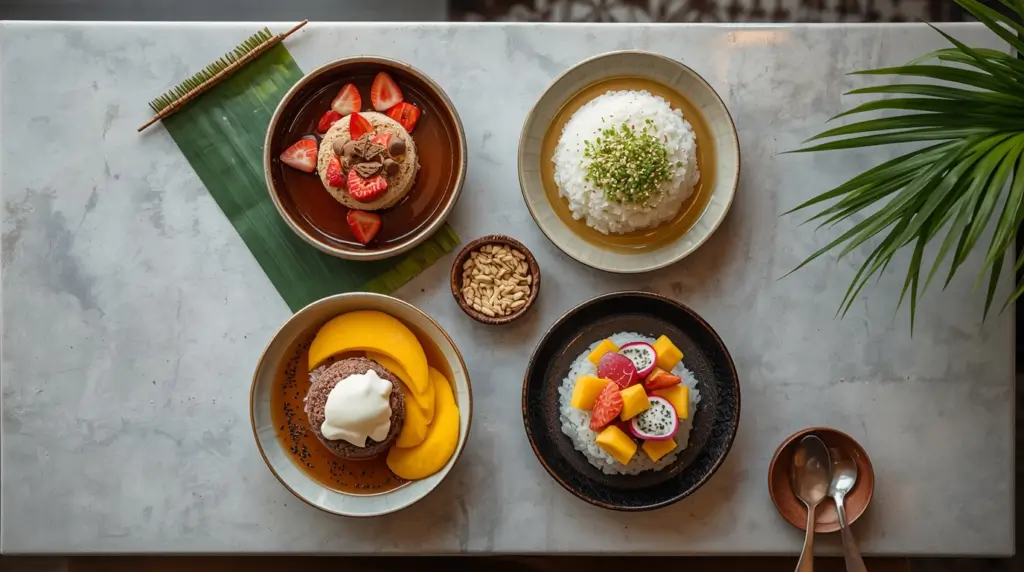
Fusion Innovations That Honor Tradition
Chocolate-Coconut Version: Fold 3 tablespoons of dark cocoa powder into the coconut sauce before mixing with rice. Top with sliced strawberries instead of mango for a Thai-Mexican fusion that surprises and delights.
Matcha Sticky Rice: Replace 2 tablespoons of water in steaming with strong-brewed green tea, and dust finished rice with culinary matcha powder. Serve with mango for beautiful color contrast.
Black Sticky Rice Variation: Use black glutinous rice instead of white for dramatic presentation and nutty flavor. Increase steaming time to 40 minutes as black rice absorbs more liquid.
Tropical Fruit Medley: Create a fruit salad with mango, fresh lychee, dragon fruit, and passionfruit. Serve over sticky rice with coconut sauce for stunning presentation perfect as chinese new year dessert ideas. This variation transforms the traditional asian dessert into a festive centerpiece.
These easy chinese dessert recipes variations transform the traditional dish while maintaining its essential character.
Picture-Perfect Presentation and Serving
Traditional Thai presentation keeps things simple; the beauty lies in the natural colors and textures. Use white plates or banana leaves to make the golden mango and pale rice pop visually. Create height by standing some mango slices vertically and laying others flat.
For modern plating, use ring molds to create perfect circles of rice. Layer thin mango slices in overlapping scales like fish scales or rose petals. Drizzle the coconut topping in an artistic swirl rather than pouring it over everything. Whether you choose traditional or modern presentation, this asian dessert always looks stunning.
Perfect Pairings
Tea Selections:
- Jasmine green tea – cuts through the richness and cleanses the palate between bites
- Thai iced tea – offers complementary coconut notes and added indulgence
- Chrysanthemum tea – provides floral notes that enhance the mango’s perfume
- Hot ginger tea – offers warming contrast if serving the dessert at room temperature
Textural Contrasts:
- Crispy fried mung beans – add delightful crunch against soft rice
- Toasted coconut flakes – provide both texture and amplified coconut flavor
- Crushed roasted peanuts – offer savory contrast to the sweet components
- Fried shallots – create unexpected savory-sweet interplay (traditional Thai addition)
Storage Solutions and Leftover Magic
This asian dessert stores well when you understand each component’s needs. Store cooked sticky rice in an airtight container at room temperature for up to 2 days. Refrigeration hardens the texture significantly, but you can rescue it by warming gently in a steamer for 5 minutes with a light sprinkle of water.
Coconut sauce keeps refrigerated for up to 5 days in a sealed container. Always warm it gently before using. Cut mangoes oxidize quickly, so prepare them shortly before serving.
Leftover Transformations: Mix leftover sticky rice with beaten eggs, form into patties, and pan-fry until golden for sweet breakfast cakes. Blend leftover mango with coconut sauce and freeze in popsicle molds for tropical frozen treats. These creative uses ensure no part of your asian dessert goes to waste.
Your Questions About Mango Sticky Rice Answered
What makes glutinous rice different from regular rice? Glutinous rice contains almost pure amylopectin starch while regular rice has both amylopectin and amylose. This gives it the signature sticky, chewy texture. Despite the name, it contains no gluten and is safe for gluten-free diets.
Can I use a rice cooker instead of steaming? Yes! Use the “sticky rice” or “sweet rice” setting if your rice cooker has one. If not, use slightly less water than for regular rice (about 1:1 ratio instead of 1:1.5).
Why is my sticky rice mushy instead of chewy? You likely added too much coconut sauce or didn’t drain the soaked rice thoroughly before steaming. Use exactly 1 1/4 cups of sauce for 2 cups of rice, and make sure rice is well-drained.
How can I tell when a mango is perfectly ripe? Ripe mangoes yield slightly to gentle pressure near the stem and smell sweet. Ataulfo mangoes should feel soft but not squishy, and the skin may wrinkle slightly near the stem.
Can I make this recipe without a steamer? Absolutely! Place a heat-safe plate on a trivet or inverted bowl inside a large pot with 2 inches of boiling water. Cover tightly.
Is this dessert served warm or cold? Traditionally, it’s served at room temperature or slightly warm. The rice should never be hot, and the mango should be cool but not refrigerator-cold.
What can I substitute for palm sugar? Light brown sugar works well, though it lacks palm sugar’s subtle caramel notes. For closer approximation, mix 1/2 cup light brown sugar with 1 teaspoon molasses. Coconut sugar also works beautifully.
How far in advance can I prepare this for a dinner party? Steam the rice up to 2 days ahead and store refrigerated. Make coconut sauce up to 5 days ahead. Cut mangoes and warm rice with sauce 2-3 hours before serving.
Ready to create the most memorable asian dessert that will have everyone asking for the recipe? Gather your ingredients and experience why mango sticky rice has captivated food lovers for generations! This easy asian dessert is perfect for beginners and experienced cooks alike.
Leave a Review
There are no reviews yet. Be the first one to write one.

